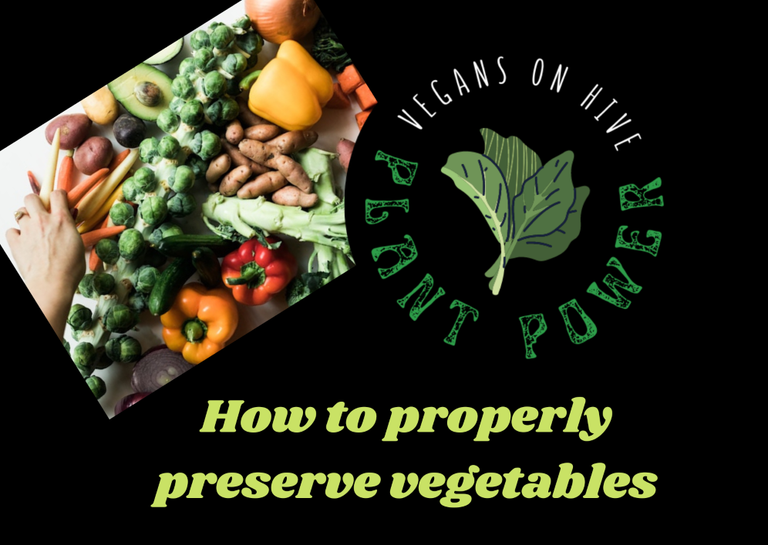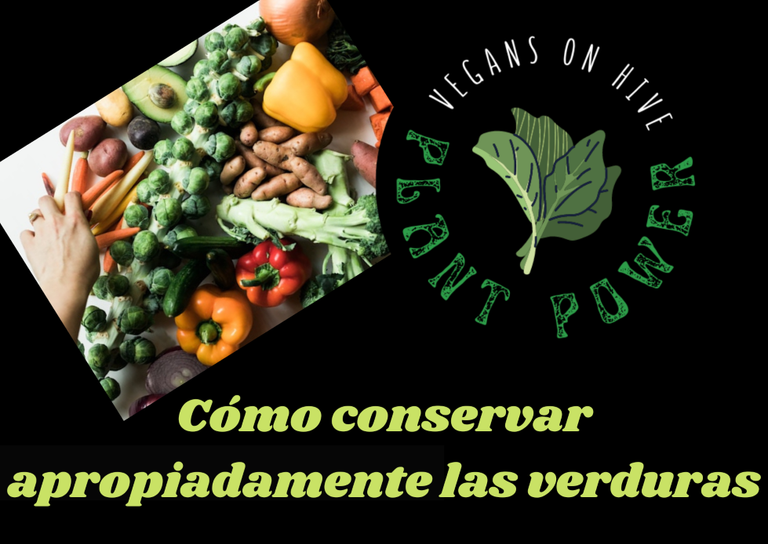
ENGLISH
Hello plant-based foodies, wherever you are in the world and/or galaxy!
Here @sirenahippie

Practical tips for preserving vegetables
- Avocados: If they're green, place them in a paper bag and store them in a dark, dry place. This will accelerate their natural ripening.
- Tomatoes: If you live in a very hot climate, tomatoes should be stored in the refrigerator, wrapped in absorbent paper and in a plastic bag. If you live in a cool climate and the tomatoes are not ripe, they can be stored outside the refrigerator in a dry, dark place.
- Chili peppers, bell peppers: Store them dry either in a dry plastic container, a plastic bag, or on a tray covered with plastic wrap.
- Leafy Green Vegetables: We've already published a post on how to preserve these types of vegetables, but in short, they should be washed or cleaned properly, dried very well, and stored in a plastic container, interspersed with absorbent paper or napkins.
- Potatoes: Clean them thoroughly, place them in a paper bag, and take them to a cool, dry place (if you live in a cool climate). If you live in a warm climate, do the same, but store them in the refrigerator. To prevent the potatoes from sprouting, place an apple near them.
- Broccoli, cauliflower, carrots, leeks, celery: Clean and dry them thoroughly, wrap them in aluminum foil, and store them in the vegetable drawer of the refrigerator.
- Onions: Store them outside the refrigerator, in a dry, airy basket. You can also put them inside a nylon stocking, but make sure they are not stuck together, tying a knot in the stocking to separate them.
- Mushrooms (fresh): Store them in the refrigerator in a brown paper bag. This way they stay fresh.
- Squash: Store outside the refrigerator in a cool, dry, and dark place.
- Garlic: Stores best outside the refrigerator, either in a basket or in a dry container in a cool, dry, and dark place.
- Zucchini, cucumbers, and eggplant: Wrap in absorbent paper inside a dry bag inside the refrigerator.

With these simple tips, you can extend the shelf life of your vegetables, keeping them in optimal condition, and thus making delicious vegan (and non-vegan) recipes


ESPAÑOL

¡Hola amantes de los alimentos basados en plantas, donde quiera que estén en el mundo y/o la galaxia!
Aquí @sirenahippie

Tips prácticos para la conservación de verduras
- Aguacates o paltas: Si están verdes, se meten en una bolsa de papel y se colocan en un sitio oscuro y seco. De este modo se acelera su maduración de un modo natural.
- Tomates: Si vives en un entorno muy caluroso, los tomates deben guardarse en el refrigerador, envueltos en papel absorbente y en una bolsa plástica. Si vives en un clima fresco, y los tomates no están maduros, se pueden almacenar fuera del refrigerador, en un sitio seco y oscuro.
- Ajíes y pimientos: Conservarlos secos ya sea dentro de un recipiente plástico seco, una bolsa plástica o en una bandeja cubierta con papel film.
- Vegetales de hojas verdes: Ya publicamos un post de cómo conservar este tipo de vegetales, pero en resumen, se lavan o limpian adecuadamente, se secan muy bien, y se conservan dentro de un recipiente plástico, intercalando papel absorbo o servilletas.
- Papas: Limpiarlas muy bien, colocalas en una bolsa de papel y llevarlas a un sitio fresco y seco (si vives en un clima fresco). Si vives en un clima cálido, hacer lo mismo, pero guardarlas en la nevera. Para evitar que a las papas les crezcan brotes, colocar una manzana cerca de ellas.
- Brócoli, coliflor, zanahoras, puerro, celery: Se limpian y secan muy bien, y se envuelven en papel de aluminio, y se guardan en la gaveta de las verduras, en el refrigerador.
- Cebollas: Guardarlas fuera de la nevera, en una cesta seca y aireada. También se pueden meter dentro de una media de nylon, pero evitando que queden juntas, haciendo un nudo en la media para separarlas entre sí.
- Setas, champiñones (frescos): Guardarlos en la nevera, en una bolsa de papel marrón. Así se mantienen frescos.
- Calabazas: Guardarlas fuera de la nevera, en un sitio fresco, seco y oscuro.
- Ajos: Se conservan mejor fuera de la nevera, ya sea en una cesta, o en un recipiente seco, ubicado en un sitio fresco, seco y oscuro.
- Calabacines, pepinos y berenjenas: Envolverlos en papel absorbo, entro de una bolsa seca, dentro de la nevera.

Con estos sencillos tips, podrán alargar la vida de los vegetales, manteniéndolos en óptimo estado, para así hacer deliciosas recetas veganas (y no veganas también)

BIBLIOGRAPHY / BIBLIOGRAFÍA

RELATED POSTS / POSTS RELACIONADOS


Delegations welcome!